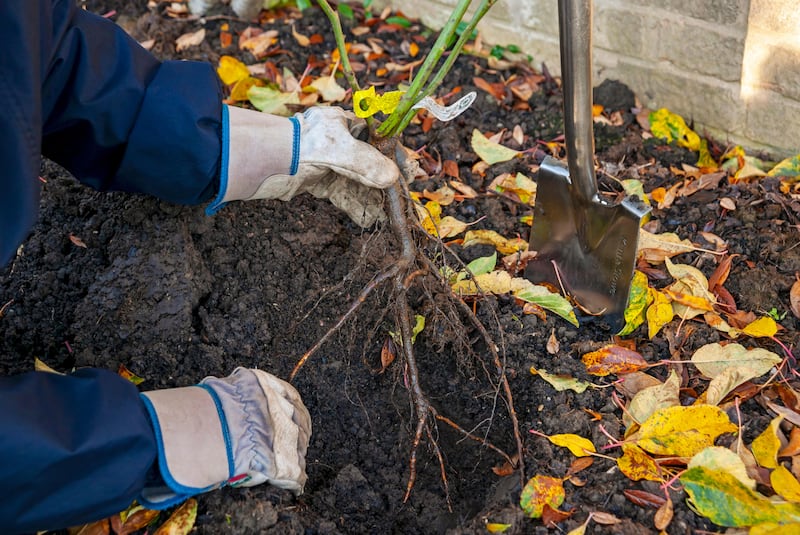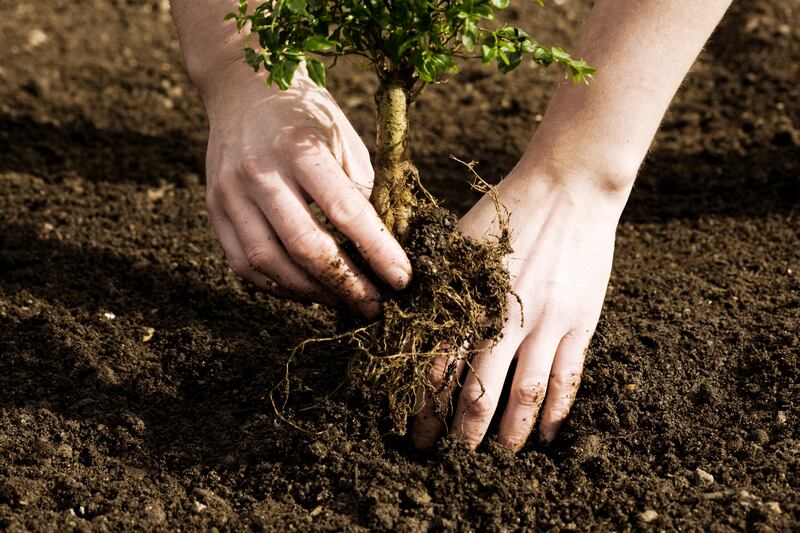November marks the proper beginning of what’s known as bare-root season, a term as stodgily dull and irrelevant to nongardeners as it is enduringly thrilling to those in the know.
Wondering how to plant up your new garden with a handsome variety of trees, shrubs, roses, fruit bushes, fruit trees and perennials without blowing your budget? Bare-root is the solution. Or possibly contemplating planting a wildlife-friendly hedge or a pocket woodland but daunted by the scale of the ground excavation required? Bare-root, my friend, bare-root.
Alternatively, maybe you’ve been searching for a hard-to-source variety online but have been deterred by the eye-watering cost of delivery? Again, bare-root plants are much lighter (there’s no pot, no compost, less packaging), making them far easier and cheaper to transport.
Perhaps you’re one of a growing tribe of gardeners dismayed by the carbon footprint of conventional container-grown garden centre plants, from the embedded energy required to produce and transport them to the peat-based compost and plastic pots typically used? Again, bare-root plants are the answer, continuing the time-honoured traditional supply chains used by garden centres and nurseries of yore, when autumn leaf fall signalled the beginning of one of the busiest planting times of the year.
That this coincides with the plant kingdom’s period of rest is no coincidence. The bare-root season, stretching from leaf-fall in autumn right through to leaf bud in early spring – except when the ground is frozen hard or waterlogged – takes clever advantage of plant dormancy. Freed from the pressures of the active growing season, when demands for water, nutrients and light are at their highest, plants can instead concentrate their energies on root growth. So unlike, say, a young summer-planted container-grown shrub whose immature root system must fight hard for it to survive, its autumn or late winter-planted equivalent can take a much more chilled-out, long-term approach.

So much so that it doesn’t have to be container-grown or root-balled. Instead, its young, entirely naked root-system can be quickly planted into a suitable planting hole, watered well and then left to happily establish itself within its new environment. Just as for any perennial plant freshly placed in the ground, all it asks for is to be watered in any prolonged dry periods in the year following planting and for the soil around its roots to be kept weed-free.
It’s worth saying that once upon a time most gardens were planted this way. But with our senses slowly dulled by the year-round availability of plants made possible by the modern horticultural industry, we’ve half-forgotten its many benefits. This lack of familiarity with bare-root plants also means we’re sometimes unsure as to how best to handle and plant them.
Transport and storage, for example, requires just a little more thought. Compared with container-grown plants, whose root systems are insulated from extremes of heat and cold and are at less risk of drying out, the naked root systems of bare-root plants are naturally more vulnerable until when they’re safely in the ground. For this reason, they should be handled with extra care and kept damp, cool but frost-free until planted, which should be done as soon as possible after purchase. If weather conditions are temporarily unsuitable (too wet, too icy), then spray their roots down with water and place them in a plastic bag inside a cool, frost-free shed. Alternatively, temporarily foot them into the ground by digging a hole, backfilling it and watering them until conditions improve.

Compared with a container-grown plant, gauging the correct planting depth is just a little bit trickier. Avoid the temptation to kill your plant with kindness by planting too deeply. Instead, bare root specimens should be planted into a very slightly raised mound of soil with the plant’s “trunk flare” – the point where the roots start to spread out from the bottom of the trunk or stem – just above soil level (2-3cm). If in doubt, look for what’s known as the “nursery line” on the trunk, which should meet the finished ground level.
Regarding the planting hole itself, recent research suggests that a wide, square, shallower planting hole is better for root establishment than the deep, round planting hole traditionally recommended. For hedging, a continuous wide, shallowish trench works well. If amending the soil in the planting hole or trench with well-rotted manure or home-made garden compost, a little is great but avoid overdoing it, as this creates its own problems, sometimes discouraging the roots from properly establishing as well as potentially causing problems with winter drainage.
When it comes to planting, gently spread the roots out wide over the base of the hole rather than leave them in a tight huddle. Also make sure that those naked root systems are very well watered before planting (I like to presoak them for a few hours in a barrow filled with a weak solution of liquid seaweed).
To prevent natural subsidence of the soil after planting, gently firm the ground with your foot as you backfill the planting hole to get rid of any air pockets. Then gently but generously water the plant again immediately after planting, before finishing off with a shallow organic mulch kept clear of any contact with the trunk or stem itself. This will help to suppress weeds, feed the soil, and further insulate the plant’s root system.
Using a weed-suppressant membrane – ideally made from a natural material that will break down over time, rather than plastic – is also very helpful in protecting young plants from competition from weeds for nutrients, light, and water. Online Irish suppliers Fruithill Farm in Cork (fruthillfarm.com) offer a great range that includes natural weed mulches made from jute, wool, coir, wood fibre and other plant-based materials.
As for selecting and sourcing bare-root plants, most good Irish garden centres carry a good range at this time of year. Where possible, try to source Irish-grown plants propagated from Irish-grown seed or cuttings, which not only supports Irish businesses and biodiversity but also reduces the risk of inadvertently introducing plant disease into your garden or allotment. The tragedy of ash dieback and the spectre of fireblight similarly afflicting hawthorn are both the result of diseased plants imported from abroad. Recommended Irish online specialist suppliers include futureforests.ie, nangleandniesen.ie, irishseedsavers.ie, nonesohardy.ie, mrmiddleton.com and quickcrop.ie
This week in the garden
Take advantage of the fact that many garden centres and specialist bulb suppliers hold sales of their remaining stock of spring-flowering bulbs at this time of year, representing especially good value, with prices often significantly reduced. But make sure to steer clear of any bulbs that look wizened, pocked, marked or bruised as these are unlikely to grow well and could possibly introduce disease into your garden or allotment.
This is a great time of the year to create a fruit garden. Currants, gooseberry, rhubarb, apple, pear, plum, medlar and raspberry varieties can all be planted as container-grown, root-ball or bare-root plants/canes. Just make sure to prepare the ground well, first by removing any weeds and large stones and amending poor soil with some well-rotted farmyard manure and/or home-made garden compost.
Dates for your diary
Thursday, November 7th (7.30-9pm): National Botanic Gardens, Glasnevin, Dublin 9, Seed for Survival; Establishing the National Seed Bank, an illustrated talk by Dr Darren Reidy on the NBG’s work to establish a seed bank at the gardens, admission free, ticketed event, heritageireland.ie, eventbrite.ie
Friday-Sunday, November 15th-17th: Establishing a Cut-Flower Business, an intensive weekend training course by Kealin & Ciaran Beattie of Leitrim Flowers, Annaghnamaddoo, Kilnagross, Co Leitrim. leitrimflowers.ie
















